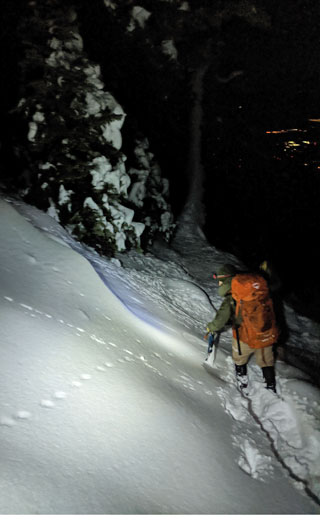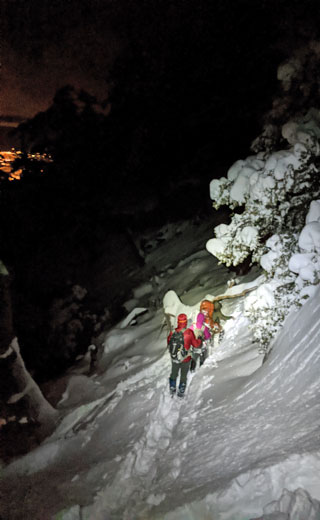Skyline Rescue
|
November 30, 2019 Top of Skyline, Grubs Notch 2019-062 |
Written by Blake Douglas
An unusually productive storm system arrived on our mountain on Wednesday, November 27th, and dumped snow for three days, culminating in the largest November snowfall in 50 years. These are the sort of conditions in which we’re surprised if we don’t receive a callout.
That inevitable callout came at 5pm on Saturday, while I was in Idyllwild with my family. Our subjects were reported to be on the Skyline trail just past Coffman’s Crag, tired and possibly lost, but not injured. Skyline is one of the most difficult trails in the country, and the sections just below the tram are probably the worst parts of the trail to travel in winter. Even in clear weather this section of the trail is steep, difficult to find and follow, and adjacent to some dangerous terrain.
Tony, James and I responded. Our plan was to follow our typical tram callout procedure; gather members and equipment at the foot of the tram road, take as many of us up together as possible, retrieve the subjects, and bring them back to the tram overnight to await the first car down in the morning, since it’s rare for a subject to make it back to the tram during its normal operating hours. James, being exhausted from a day of hiking, would run base, and Tony and I would be Team 1.
After checking in with the State Parks officers in Long Valley, we followed a set of recent snowshoe tracks over Grubb’s Notch and down a few of the switchbacks, where the tracks abruptly ended, and we broke trail from that point forward. Travel was slow and moderately difficult, even with snowshoes we were post holing more than a foot deep in several places. On the bright side the weather was perfect for a rescue, with no wind, and temperatures slightly above freezing, although this did mean that the trees were melting onto us continuously.
When we reached our subjects’ elevation, we briefly considered attempting a traverse, but the depth of snow and the terrain between us made it immediately clear that this path wasn’t worth the attempt. We decided to descend and continue breaking trail until we either found our subject’s tracks or had a clear line of sight to them. At this point we had cell phone and occasional voice contact, but they seemed to be on the other side of a ridge.

Blake Breaking Trail to Subjects.
Image by Tony Hughes.
We found their tracks about 30 minutes later, branching abruptly from the trail and up a drainage, following a set of deer tracks. It was never clear to us why they followed the deer tracks when those tracks clearly broke from the trail well before the ascent to Grubb’s Notch, but my assumption is that Gaia failed to acquire their location due to the amount of rock in that area. Other similar locations in our mountains, such as Caramba, have done the same thing; another reason to carry a map and compass.
The ascent to our subjects was probably one of the more difficult hikes I’ve endured on a mission. I kept thinking “any second now, they’ll be right over that next tree…past that next rock…yep, any second now… only to have Tony check Gaia and find that we were still hundreds of feet below them.
If you’ve never hiked Skyline and you’re reading this as a means of learning about the trail, know this; the trail never involves bushwhacking, nor rock climbing. If you’re doing either of these things, you’re not on the trail.
We reached our subjects around midnight, on top of a small promontory that required a 10-foot climb to reach them, which was fortunately easy to navigate and had some solid hand and footholds. They were cold but in good spirits and ready to hike out immediately; after we all warmed up with some hot drinks and food, we began the long trip back to the tram. This time I didn’t wear my snowshoes because our subjects didn’t have any either; it would be better if I found postholes and kicked steps rather than letting our subjects potentially injure themselves doing so. All this together meant the 2-mile round trip took 7 hours.

Blake Leading Subjects Out.
Image by Tony Hughes.
We arrived at the tram around 3am, ready for a few hours of sleep on the floor and a quiet ride down the mountain at sunrise.
What went wrong:
There were several things that went right with this mission, and we were confident that our subjects would have survived the night if we weren’t able to reach them. The three main problems that led to this mission were a lack of familiarity with the trail and terrain, a lack of snowshoe traction, and a lack of overnight gear.
First, if you know you’re going into snowy terrain, bring snow traction. Snowshoes, crampons, and/or micro-spikes – any of them are better than nothing. If you haven’t broken trail in snow before, expect it to be many times harder than hiking in clear conditions and plan accordingly.
Second, if you’re hiking a difficult wilderness trail, try to hike or scout it first when it’s snow-free, so you aren’t doing guesswork trail-breaking if your navigation equipment fails. Check your navigation frequently to ensure that you’re on the trail, especially in sections when going off-trail means wasting valuable time and energy and getting into potentially deadly terrain.
RMRU Members Involved: Douglas Blake, James Eckhardt, and Tony Hughes.
